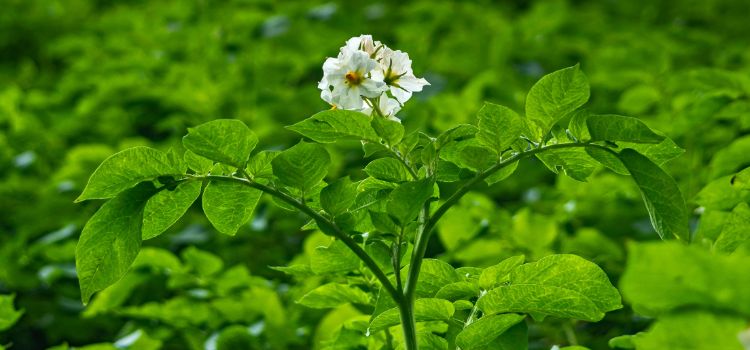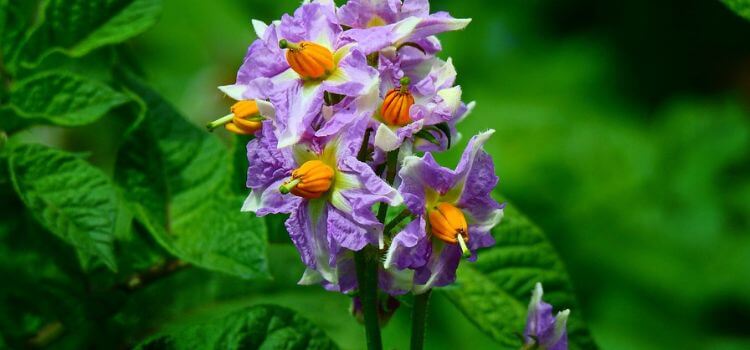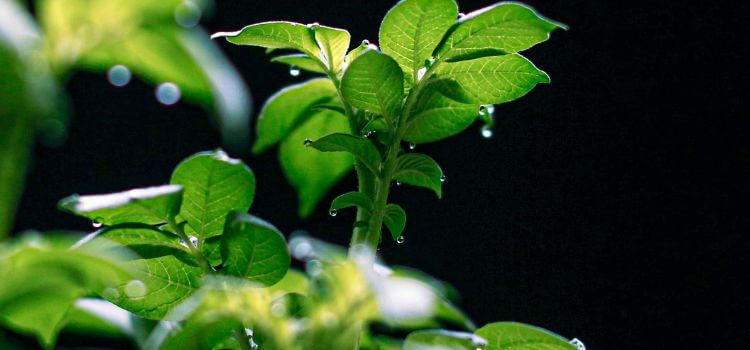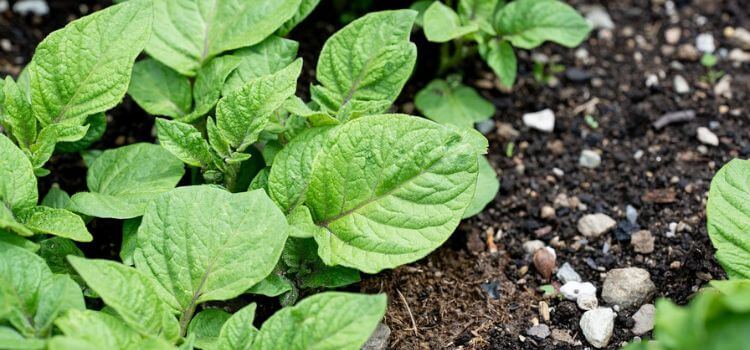As an Amazon Associate, I earn from qualifying purchases.
A potato plant has green, leafy stems with small white, pink, or purple flowers. Its underground stems produce edible tubers.
Potato plants, commonly found in gardens and farms, are essential in many cuisines worldwide. They have bushy green foliage and typically reach 12 to 18 inches in height. The plant’s flowers can vary in colour, including white, pink, or purple.
These flowers develop into small, non-edible fruits. Beneath the soil, the plant forms tubers, which are the potatoes we consume. These tubers grow from underground stems called stolons. Potato plants thrive in well-drained soil and need consistent watering. Their growth cycle spans approximately 90 to 120 days, making them a relatively quick and rewarding crop for growers.
What Do Potato Plants Look Like?
Potato plants are fascinating to observe. These plants are not only crucial for our diet but also have unique characteristics. So, what do potato plants look like? Let’s explore their structure, leaves, and flowers to understand them better.
Plant Structure
The potato plant has a bushy appearance. It can grow up to 3 feet tall. The plant has a central stem that is sturdy and green. From this main stem, several branches spread out. The stem can sometimes have a purplish tint. Underground, the plant grows tubers, which are the potatoes we eat.
Leaves Of A Potato Plant
The leaves of a potato plant are green and compound. Each leaf is made up of several smaller leaflets. These leaflets are oval-shaped and have smooth edges. The leaves are arranged in a spiral pattern around the stem. This arrangement helps the plant capture more sunlight for photosynthesis.
Flowers And Fruits
The potato plant produces small, star-shaped flowers. These flowers can be white, pink, or purple. They grow in clusters at the top of the plant. After flowering, the plant can produce small green fruits. These fruits look like tiny tomatoes but are not edible. They contain seeds, but potatoes are usually grown from tubers, not seeds.

Growth Stages For Potato Plants
Have you ever wondered what a potato plant looks like? Understanding the growth stages of a potato plant can help you recognize its development. Let’s explore the different phases a potato plant goes through, from sprouting to flowering.
Sprouting Stage
In the sprouting stage, potato tubers begin to show small shoots called “eyes.” These eyes are the start of the new plant. If you cut a potato and see these eyes, it means the potato is ready to sprout. Place the tuber in a warm, dark place. After a few days, the shoots will start to grow.
Vegetative Growth Stage
The vegetative growth stage is when the potato plant starts to grow leaves. These leaves are important for photosynthesis. During this stage, the plant will grow taller and spread out. The leaves are usually green and have a slightly rough texture. This stage provides the energy needed for the plant to produce tubers.
Flowering Stage
In the flowering stage, the potato plant produces small, white, or purple flowers. These flowers are a sign that the plant is healthy and growing well. Not all potato plants will flower. Flowering can depend on the variety and growing conditions. After the flowers bloom, the plant will focus on increasing the tubers underground.
Environmental Needs
Potato plants are fascinating and versatile. They require specific environmental conditions to thrive. Understanding these needs is crucial for successful cultivation. This section delves into the essential environmental needs of potato plants.

Soil Requirements
Potato plants thrive in well-draining, loose soil. Compact soil can hinder tuber growth. Sandy loam is ideal due to its texture and drainage properties. Maintaining a slightly acidic pH between 5.0 and 6.0 is beneficial. Incorporating organic matter like compost improves soil fertility and structure. Avoid planting potatoes in soil that has grown other nightshades recently to prevent disease.
Sunlight And Water Needs
Potato plants need full sunlight, which means at least six hours of direct sunlight daily. More light can result in smaller tubers. Watering is crucial, especially during the growing season. Potatoes require consistent moisture but avoid waterlogging. Drip irrigation or soaker hoses are effective methods. Over-watering can lead to rot and disease. Constantly monitor soil moisture to keep it evenly moist but not saturated.
Common Varieties Of Potato Plants
Potato plants are fascinating to observe. They come in many shapes and sizes. The leaves are green and lush, and the flowers can be white, purple, or pink. Let’s explore some common varieties that you might encounter in your garden or at the grocery store.
Russet Potatoes
Russet potatoes are easily recognizable. They have a brown, rough skin. The inside is white and starchy. These potatoes grow large and are often used for baking and mashing. The plants have dark green leaves and can grow quite tall. Flowers are usually white with yellow centers.
Red Potatoes
Red potatoes are smaller and have smooth, red skin. The flesh inside is creamy and moist. They are perfect for boiling and roasting. The plants have vibrant green leaves. The flowers are typically light purple or pink. These potatoes are often found in salads because they hold their shape well.
Fingerling Potatoes
Fingerling potatoes have a unique shape. They are long and narrow, resembling fingers. The skin can be yellow, red, or purple. The flesh inside is buttery and firm. These potatoes are great for roasting. The plants are compact and bushy. Flowers can be white or purple. Fingerling potatoes add a gourmet touch to any dish.

Pests And Diseases
Potato plants, with their lush green leaves and underground tubers, are a sight to behold in any garden. However, these plants often face threats from various pests and diseases. Understanding these challenges helps maintain healthy potato crops and ensures a bountiful harvest.
Common Pests Affecting Potato Plants
Several pests target potato plants, causing significant damage:
- Colorado Potato Beetle: This beetle has yellow and black stripes. It lays orange eggs on the leaves, and its larvae eat the foliage.
- Aphids: These tiny, green, or black insects suck sap from the plant, weakening it and spreading diseases.
- Wireworms: These pests are the larvae of click beetles. They tunnel into the tubers, making them inedible.
- Potato Tuberworm: This small moth lays eggs on the plant. The larvae burrow into the tubers, causing significant damage.
Diseases That Impact Potato Plants
Potato plants are prone to various diseases, often caused by fungi, bacteria, or viruses:
- Late Blight: A fungal disease that causes dark spots on leaves and tubers. It spreads quickly in wet conditions.
- Early Blight: Another fungal disease, it creates brown spots on older leaves. These spots have concentric rings.
- Blackleg: Bacterial infection that causes black stems and wilting. It starts at the stem base and moves upwards.
- Potato Virus Y (PVY): A viral disease that causes mottled leaves and reduces tuber yield. Aphids often spread this virus.
Harvesting And Storage
Ever wondered what a potato plant looks like and how to harvest and store its tubers? Potato plants have green, leafy stems and produce small, white, or purple flowers. But the real treasure lies underground in the form of delicious potatoes. Knowing when and how to harvest and store them ensures you get the best quality and taste.
Signs That Potatoes Are Ready For Harvest
Knowing when to harvest potatoes is crucial for getting the best crop. Look for these signs:
- Yellowing leaves: The leaves start to turn yellow and die back.
- Flowering: Some potato varieties flower, indicating tuber formation.
- Size check: Gently dig around the plant to check the size of the tubers.
Once you see these signs, your potatoes are likely ready for harvest. Harvesting too early can result in smaller potatoes while waiting too long can prevent them from rotting.
Proper Storage Techniques
Storing potatoes keeps them fresh for more extended periods. Follow these steps:
- Drying: Lay the potatoes out in a cool, dark place to dry for a few hours.
- Cleaning: Brush off excess dirt, but avoid washing them until use.
- Storage conditions: Store in a cool (45-50°F), dark, and well-ventilated area.
- Container choice: Use burlap sacks or ventilated boxes to allow air circulation.
Ensure they are not exposed to light to prevent greening and sprouting. Proper storage extends their shelf life, keeping them edible for months.

Frequently Asked Questions Of What Does A Potato Plant Look Like
Identify a potato plant by its green, oval leaves with wavy edges. It has white or purple flowers. Look for underground tubers.
A potato plant has green, leafy stems and can reach up to 3 feet tall. The leaves are compound, with multiple leaflets. Small, white, or purple flowers bloom, followed by underground tubers.
Potatoes typically take 70 to 120 days to grow, depending on the variety and growing conditions. Early varieties mature faster. Proper care, such as watering and soil quality, can influence growth time. Harvest when the foliage turns yellow and dies back.
A potato is ready to harvest when its vines turn yellow and begin to die back. The skin should be firm and not easily rubbed off.
Conclusion
A potato plant is a fascinating addition to any garden. With its lush green leaves and delicate white or purple flowers, it captivates the eye. Understanding its appearance helps in proper care and cultivation. Start growing your potato plants to enjoy fresh, homegrown potatoes right from your garden.

